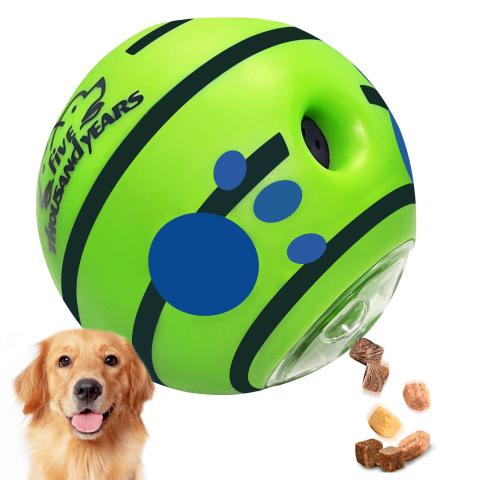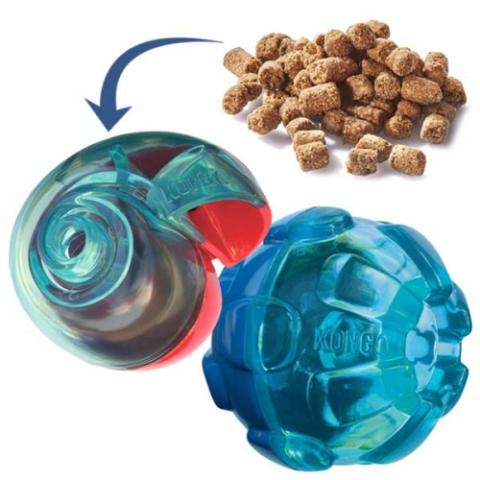
Dog Treat Balls: The Perfect Toy for Fun, Exercise, and Training
Published on November 14 by Julia
Dog treat balls are a popular and practical solution for pet owners looking to keep their dogs engaged, entertained, and active. These versatile toys can serve as both a fun distraction and a tool for positive reinforcement during training. Whether you want to slow down a fast eater, provide mental stimulation, or reward your pup for good behavior, dog treat balls offer a range of benefits for both dogs and their owners.
In this article, we’ll explore what dog treat balls are, the different types available, their benefits, and how to use them to enhance your dog's physical and mental well-being.
What Are Dog Treat Balls?
A dog treat ball is a hollow, durable ball designed to hold treats or kibble. It typically features a small opening or adjustable compartment that allows pet owners to insert treats, food, or peanut butter. As the dog plays with the ball, it dispenses treats gradually, encouraging active engagement. These balls come in various sizes, shapes, and materials, each catering to different dog breeds, sizes, and play preferences.
Dog treat balls are designed to be interactive. They stimulate your dog’s brain, keep them occupied, and can be used as a tool for training or behavior management.
Types of Dog Treat Balls
Dog treat balls come in many forms, each offering unique features to cater to your dog’s specific needs. Here are the most common types:

1. Classic Treat Balls
These are simple, round balls made from rubber, silicone, or hard plastic. They have a hole or several openings through which treats or kibble can fall out when the ball is rolled or chewed. Classic treat balls are great for dogs that love to chase and roll their toys.
2. Puzzle Treat Balls
Puzzle treat balls feature intricate designs that require your dog to solve a puzzle to release the treats. These balls are excellent for mental stimulation, as they challenge your dog’s problem-solving abilities. Some puzzle balls may require the dog to move parts or rotate the ball in a certain way to access the treats inside.
3. Treat Dispensing Chew Balls
Made of more durable materials like rubber or nylon, these balls allow dogs to chew on them for extended periods while releasing treats as they gnaw. These balls can be a great option for heavy chewers, as they combine the benefits of a chew toy with a treat-dispensing function.
4. Squeaky Treat Balls
Some treat balls come with a squeaker built into the center, adding an extra layer of excitement to your dog’s playtime. The squeak helps keep dogs engaged, making the toy even more enticing and fun.
5. Tug-and-Treat Balls
Some treat balls are designed with a handle or rope, allowing for both fetch and tug-of-war play. These are great for interactive play sessions, where both you and your dog can enjoy some bonding time while the ball dispenses treats.

6. Treat Balls for Slow Feeders
For dogs that tend to eat too quickly, some treat balls are designed to slow down feeding. These slow feeder balls release food gradually as your dog interacts with the toy. This helps prevent indigestion, bloating, and obesity that can arise from rapid eating.
Benefits of Dog Treat Balls
Using treat balls as part of your dog’s daily routine provides several physical, mental, and behavioral benefits. Here’s why they are so valuable for dogs of all ages and activity levels:
1. Mental Stimulation
Dog treat balls are an excellent way to keep your dog’s mind sharp. Many dogs thrive on mental challenges, and a treat ball that requires problem-solving, such as a puzzle ball, can keep your dog entertained while also stimulating their cognitive abilities. This can help reduce boredom, anxiety, and destructive behaviors that stem from a lack of mental engagement.
2. Physical Exercise
Most dogs love to chase and play with balls, and treat-dispensing balls encourage movement, whether your dog is rolling the ball around or chasing it across the yard. This helps keep your dog active, promotes weight management, and encourages exercise even when you're not home to take them on walks.
3. Slows Down Eating
Dogs that eat too quickly may be prone to indigestion, choking, or even bloat (gastric torsion). Treat balls, especially slow feeder models, can help control the speed at which your dog eats by dispensing food or treats slowly, encouraging them to work for their meal. This can improve digestion, reduce the risk of vomiting, and ensure a more mindful eating process.

4. Prevents Destructive Behavior
If your dog is prone to chewing furniture or digging, a treat ball can be a great distraction. By offering an alternative form of entertainment that keeps your dog occupied, treat balls can help prevent unwanted behaviors caused by boredom or anxiety.
5. Training and Positive Reinforcement
Treat balls are an effective tool for training. You can use them as part of a reward-based system to reinforce good behavior. Whether you’re teaching your dog to fetch, sit, or stay, a treat ball can serve as a rewarding and interactive way to practice new commands.
6. Interactive Play and Bonding
Treat balls can provide an excellent opportunity for interactive play between you and your dog. By tossing the ball or engaging in tug-of-war, you foster a strong bond with your pet. Some balls also allow for mutual play, like tug-and-treat balls, which can encourage teamwork and communication between you and your dog.
How to Use Dog Treat Balls
Using a dog treat ball is relatively simple, but there are a few tips to maximize the effectiveness of the toy:
- Choose the Right Size and Material: Make sure the treat ball is the right size for your dog. A ball that is too small may pose a choking hazard, while one that’s too large may be difficult for your dog to play with. Also, select a ball made of durable materials that can withstand your dog’s chewing habits.
- Start Slow: If your dog is new to treat balls, start by showing them how the ball works. Put a few treats inside and demonstrate by rolling or shaking the ball to encourage them to engage with it. This helps your dog understand how the toy functions.
- Gradually Increase Difficulty: If you’re using a puzzle treat ball, start with a low level of difficulty and gradually increase the challenge as your dog becomes more skilled at solving it. This will keep them engaged and prevent frustration.
- Use as a Training Tool: Treat balls can be incorporated into training routines. For example, use the ball to reward your dog for performing certain commands or completing an obstacle course. This creates a fun and positive association with training sessions.
- Supervise Play: Always supervise your dog during playtime, especially with new toys. Ensure they don’t accidentally swallow small parts or become overly frustrated if the toy becomes too difficult to figure out.
Conclusion: Why Dog Treat Balls Are a Must-Have Toy
Dog treat balls are a fun and multifunctional addition to your dog’s toy collection. They offer numerous benefits, from providing mental stimulation and physical exercise to encouraging slow eating and positive behavior. With so many types available, you can choose a treat ball that best suits your dog’s personality, play style, and health needs.
By introducing treat balls into your dog’s routine, you can enrich their life, promote good health, and strengthen the bond between you and your furry friend. Whether used for training, play, or as a slow feeder, a treat ball can become an essential part of your dog’s daily enrichment plan.